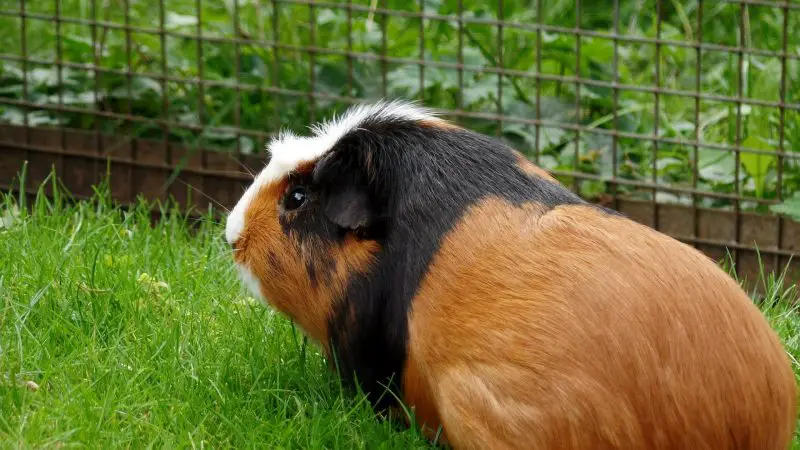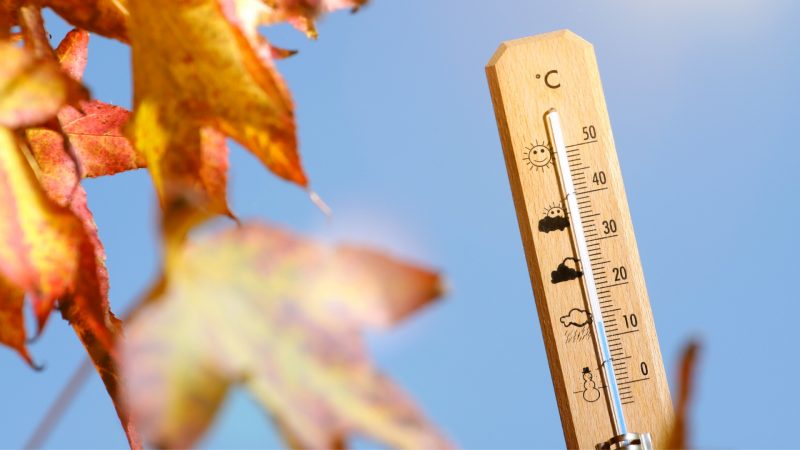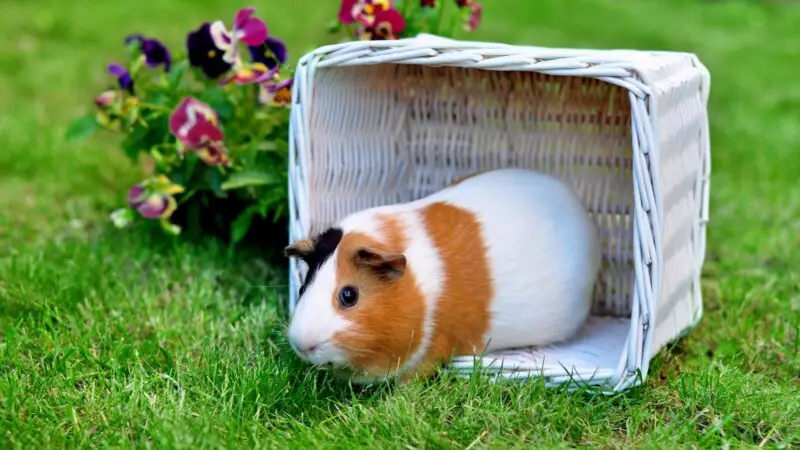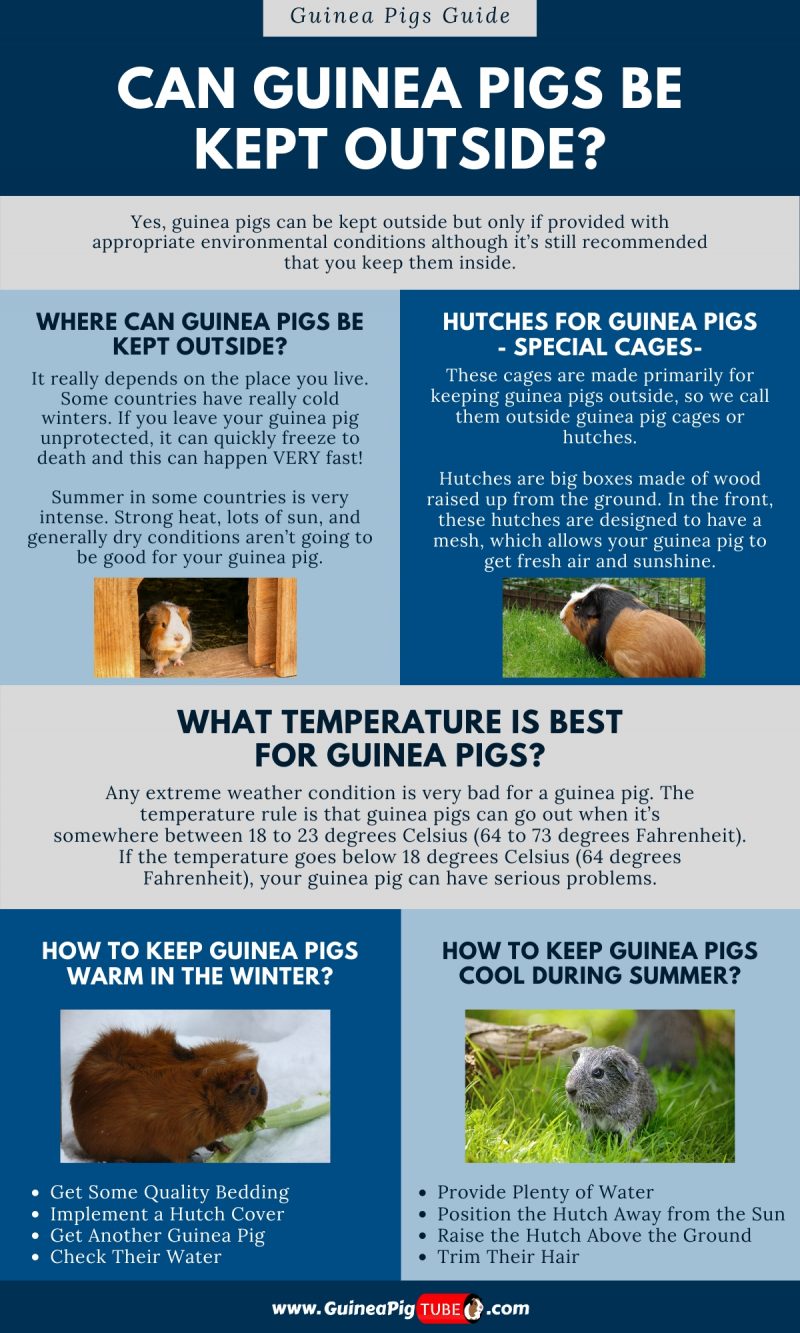Guinea pigs are one of the most interesting pets on the planet. They are extremely affectionate and cute and they love to be near humans. We have been getting lots of questions on if guinea pigs can be kept outside. If you are living that has relatively ideal temperatures for guinea pigs, keeping them outside won’t present a problem.
It’s still recommended that you keep them inside. However, you can keep them outside but only if provided with appropriate environmental conditions.
In order to keep guinea pigs outside during the winter, you must have a guinea pig hutch/cage with good isolation and proper bedding. During summer, the cage needs to have plenty of shade and good airflow.
Table of Content
Where Can Guinea Pigs Be Kept Outside?

It really depends on the place you live in. Some countries like the USA (in some states), Norway, Sweden, Finland, Iceland, and the UK have really cold winters. In the UK, the temperature is also a bit lower with lots of rain, while in the USA it really depends on the state.
If you leave your guinea pig unprotected, it can quickly freeze to death and this can happen very fast! If you plan on keeping your pets outside, you need to build or buy a special cage with lots of isolation and a high-quality top/cover to prevent rain from getting inside the cage.
On the other hand, summer in some countries is very intense. Strong heat and generally dry conditions aren’t going to be good for your guinea pig. In this case, you’ll need to make a special shelter and place it somewhere where the sun is weaker. On top of that, you’ll need to constantly provide fresh water for the guinea pigs, as guinea pigs mostly drink cold water.
The best time for keeping your guinea pig outside is probably springtime, as weather conditions aren’t that extreme.
What Temperature Is Best for Guinea Pigs?

This one is a bit debatable, as every guinea pig is sometimes drastically different. Any extreme weather condition is very bad for a guinea pig.
The temperature rule is that guinea pigs can go out when it’s between 18 to 23° C (64 to 73°F). If we compare guinea pigs to humans, this temperature is also a sweet spot for many of us.
If the temperature goes below 18°C (64°F), your guinea pig can have serious problems. It can either freeze to death or go into a state of hypothermia. If it’s very hot outside, heatstroke can happen. In either case, the body has a response to extreme weather conditions.
When a guinea pig is feeling hot, the blood flow to the skin increases, letting them cool down a bit. When the blood flows faster, the blood pressure is also higher, leading to heatstroke. During cold days, the blood flow will give in to the coldness in order to conserve heat. This can lead to freezing.
How to Keep Guinea Pigs Warm Outside in the Winter?

If you live in some of the aforementioned countries, the chances of keeping your guinea pig warm outside during the winter are very small. However, if you live in a country where the winter isn’t as strong, you can do the following things:
1. Get a Quality Bedding
Quality bedding is always needed for your guinea pig. However, during the winter, extra care should be put. Not just that it needs to be comfortable and soft, but also very warm for your guinea pig.
That’s why you should always add more bedding and also some hay, as it preserves heat very well. Be sure to check the bedding every once in a while to determine if it’s wet. The wet bedding should be removed immediately!
Also, if you can, try to make a guinea pig cage a bit smaller. If it’s too big, you’ll need a lot more hay and it can’t get warmer very fast.
Related: Best Bedding for Guinea Pigs in 2022: Top 8 List With Ultimate Reviews and Guide
2. Implement a Hutch Cover
A hutch cover is obligatory as it protects your guinea pig and the cage from rain, snow, or any other weather condition.
If rain falls all over the cage, the bedding can get soaked, making your guinea pig sleep on the wet bedding. If your guinea pig sleeps on cold water, it can get cold and can start coughing and vomiting. This is something that you want to avoid.
The best way to do it is to try and cover the majority of the cage/hutch. But still, leave some space for the air to flow. Never leave your guinea pigs without fresh air.
3. Get Another Guinea Pig
If you manage to buy another guinea pig or perhaps two more, the heat will be shared between them, allowing them to survive the winter much easier.
This can also be applied to people. When it’s hot outside, you want to be alone, and when it’s cold, you just want someone to snuggle with. That’s the case with guinea pigs, too!
If you have two or three guinea pigs, it will be much easier for them to snuggle together. Thus, sharing the heat with each other.
4. Check Their Water
If the temperature reaches below 0°C (32°F), the water will usually freeze. Having in mind that you want to keep a guinea pig outside, the water will also be outside, increasing the chances for this to happen.
To prevent this, you can secure your water bottle within the hutch and place a hot towel around the bottle. This will prevent their water from freezing, at least for some period of time. Alternatively, you can always hide it under the hay and then place a towel.
How to Keep Guinea Pigs Cool Outside in the Summer?

Keeping your guinea pigs outside in the summer is much easier to do. Still, you’ll have to take certain precautions to avoid heatstroke.
1. Provide Plenty of Water
To survive a very hot summer, simply drink a lot of fresh water! Water will not only keep your guinea pigs hydrated but also serve as a cooling agent.
When you give your guinea pigs some cold water during summer, it can get hot pretty fast. In this case, you’ll need to check their water often, as well as position the water away from the sun and deep into the shade.
2. Position the Hutch Away from the Sun
To prevent water from heating pretty quickly, hiding your hutch away in the shade is the best option. It’s important not only for water but also for your guinea pig!
They can easily get a heat stroke if you don’t keep them away from the sun, especially if you have more than two guinea pigs. Next time you plan on putting the hutch directly in front of your house, think about it again.
3. Raise the Hutch Above the Ground
When the intense heat starts, the ground warms up pretty fast. If you have a lot of concrete in your yard and less grass, this heat will be significantly higher. This means that placing the hutch directly on the ground isn’t a great idea.
You can, however, place it on the table or simply create additional legs for it and raise it above. The interesting thing is that most high-quality hutches that you can buy, already have this possibility, so you don’t need to build anything.
4. Trim Their Hair
Some guinea pigs have long hair. Be sure to trim their hair often in order to keep them cool. When trimming, excessive hair is eliminated, making a guinea pig cooler and less prone to heatstroke during the summer.
Related: 5 Best Guinea Pig Grooming Kit (Must Read!)
What Is the Best Guinea Pig Outside Cage?

If you want to keep guinea pigs outside, you will need to make or buy a special guinea pig cage. These cages are made primarily for keeping guinea pigs outside, so we call them outside guinea pig hutch or cages.
- Upgraded to plastic tray. This rabbit cage suitable for 2-3 rabbits or 3-4 Guinea pig or like size animal.
- Overall Size: Exterior :62"(L) x 21.0"(W) x 37.0"(H) / Upper House size: 27.5"Lx18"x20.5"H / Stairsdoor size:7"Wx6"H
- Sturdy Construction & Weatherproof: Constructed by premium natural fir wood and painted with eco-friendly waterproof non-toxic varnish. The original wood is firm and natural for your beloved pet.
- Spacious Space & User-friendly Design: This 62" Guinea Pig Condo There is sliding door and ramp allows Pet to easily enter the raised housing area. There are timber ridges above the ramp to protects your Pet from slipping back. With the design of grid door you can watch your pets without disturbing.
- Removable tray & Grid Fences: There is removable bottom sliding tray for easy cleaning. High quality grid fences provide a healthy poultry lifestyle. With the pitched roof your poultry can run outside even in rainy days. The fences are vital to the ventilation of poultry, they will also protect your poultry from the outside predators.
Hutches are big boxes made of wood raised up from the ground. In the front, these hutches are designed to have a mesh, which allows your guinea pig to get fresh air and sunshine.
These types of cages can keep your guinea pig warm and dry in the winter or cold during the summer. But you still need to put beneath them some type of bedding and hay because of the mesh in front.
You can also get a hutch cover that will protect your guinea pig from bad weather conditions, like rain or snow. Hutches can also be very big and they will provide your guinea pigs with much more space. You can have hutches as an indoor cage if you have enough space, but they are used more often as an outside cage.
In hutches, guinea pigs will be safe from other animals and predators, with solid accommodation and the mesh in front of the cage enables them a good connection with the environment.

Summary
Guinea pigs came to our homes living outside (they were once wild animals). Thus, they can definitely live and survive outside of your house. However, a guinea pig isn’t the most enduring animal as it can easily suffer from the consequences of extreme weather conditions.
Bear in mind that you’ll need additional bedding for keeping guinea pigs outside during the winter. In the summer, you’ll need to get them away from the sun.
List of Sources
Influence of Temperature on Performance in Guinea Pigs
Response of the Guinea Pig Heart to Hypothermia
Management of Skin Conditions in Guinea Pigs
Cold Adaptation in Guinea Pig at Level of Isolated Brown Adipocyte
Responses of Pontine Units to Skin‐Temperature Changes in the Guinea‐Pig

